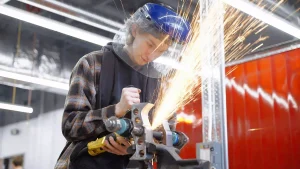We’ve experienced a revolution in metalwork, thanks to the empowerment brought by metalworking tools. With the availability of high-quality tools and advancements in technology, we now have the ability to bring our visions to life with precision and finesse.
Design plays a vital role in guiding our creative process and maximizing the potential of these tools. By carefully considering every aspect of our design, we can create stunning works of art that showcase our craftsmanship and resonate with the audience.
Let’s unlock the true potential of metalwork together and create masterpieces that leave a lasting impact.
Key Takeaways
- Metalworking tools are essential for shaping, cutting, and joining metal materials, enabling the creation of intricate designs and sturdy structures.
- Design plays a crucial role in enhancing craftsmanship by improving precision and accuracy, streamlining workflows, and increasing efficiency.
- Understanding the capabilities of metalworking tools and utilizing them fully is key to unlocking creativity and achieving high craftsmanship.
- Innovations in metalworking tools, such as advanced CNC machines, high-performance cutting tools, 3D printing technology, and smart tools, revolutionize craftsmen’s work by offering unparalleled accuracy, speed, and the freedom to explore new possibilities in metalwork.
The Importance of Metalworking Tools in Empowering Your Craft
As metalworkers, we greatly benefit from the importance of metalworking tools in empowering our craft. These tools are essential for shaping, cutting, and joining metal materials, allowing us to create intricate designs and sturdy structures.
From hammers and anvils to welding machines and plasma cutters, each tool serves a specific purpose in the metalworking process.
With the right tools at our disposal, we’ve the freedom to bring our creative visions to life and push the boundaries of what’s possible in metalwork.

Exploring the Revolution in Metalwork: How Design Enhances Craftsmanship
We, metalworkers, witness a revolution in metalwork as design enhances our craftsmanship. With the advancements in design, we’re able to push the boundaries of what’s possible in metalworking. Here are some ways in which design enhances our craft:
- Improved precision and accuracy in shaping metal
- Streamlined workflows and increased efficiency
- Enhanced functionality and versatility of metalworking tools
- Greater creativity and innovation in metalwork designs
These advancements empower us to create truly exceptional pieces and push the limits of our craft, giving us the freedom to explore new possibilities in metalwork.
Maximizing the Potential of Metalworking Tools for Empowered Artistry
To truly maximize the potential of our metalworking tools, we must explore the various techniques and strategies that empower our artistry. By understanding the capabilities of our tools and utilizing them to their fullest extent, we can unlock a world of possibilities in our metalwork.
From precision cutting and shaping to intricate detailing and finishing, our tools are the key to unleashing our creativity and achieving the highest level of craftsmanship. With the right knowledge and skill, we can harness the power of our metalworking tools to create truly empowering and liberating works of art.
The Role of Design in Transforming Metalwork: Unleashing Creativity and Precision
With a deep understanding of design principles and a keen eye for detail, we can unleash our creativity and achieve unparalleled precision in transforming metalwork.
Design plays a crucial role in this transformation, allowing us to push the boundaries of what’s possible. By incorporating innovative design elements, we can create unique and intricate metalwork pieces that showcase our artistic vision.
Furthermore, design enables us to optimize functionality and ergonomics, ensuring that our creations aren’t only beautiful, but also practical.
Through design, we’ve the freedom to explore new possibilities and elevate our metalworking craft to new heights.
Empowering Your Craft: Harnessing the Power of Metalworking Tools
By utilizing a variety of metalworking tools, we can enhance our craft and achieve impressive results.
Metalworking tools empower us to shape, cut, and manipulate metal with precision and efficiency.
Whether it’s a lathe for turning metal, a milling machine for creating intricate designs, or a welding machine for joining pieces together, these tools give us the freedom to bring our creative visions to life.
With the power of metalworking tools, we can push the boundaries of what’s possible in our craft and unlock new levels of craftsmanship.
Innovations in Metalworking Tools: Revolutionizing the Way Craftsmen Work
We wholeheartedly embrace the remarkable innovations in metalworking tools that are revolutionizing the way craftsmen work. These advancements are empowering craftsmen to push the boundaries of their craft and achieve new levels of precision and creativity.
Here are some of the key innovations that are transforming the metalworking industry:
- Advanced CNC machines that offer unparalleled accuracy and speed
- High-performance cutting tools that optimize productivity and minimize waste
- 3D printing technology that allows for intricate and complex metal designs
- Smart tools and automation systems that streamline workflows and enhance efficiency
With these innovations, craftsmen have the freedom to explore new possibilities and redefine what’s possible in metalwork.
Conclusion
In conclusion, the fusion of metalworking tools empowerment and design has revolutionized the craft of metalwork, enabling craftsmen to push the boundaries of their creativity and create truly remarkable pieces.
Through careful consideration of every aspect of design, from functionality to aesthetics, metalworkers can maximize the potential of their tools and transform raw materials into stunning works of art.
By harnessing the power of these tools and embracing innovative techniques, we can unlock the true potential of metalwork and leave a lasting impact on the world of craftsmanship.
You May Also Like:

